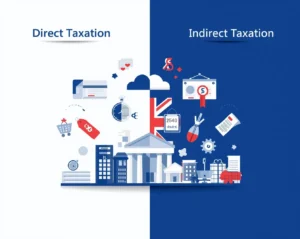In the United Kingdom, VAT (Value Added Tax) is a crucial part of the tax system, affecting millions of businesses across various industries. For businesses, correctly managing VAT returns is not just a legal requirement but an essential part of financial planning and maintaining compliance with HMRC (Her Majesty’s Revenue and Customs). However, the process of submitting VAT returns can often be complex, particularly for smaller businesses.
To streamline and simplify this process, HMRC introduced the Making Tax Digital (MTD) initiative, which aims to reduce paperwork and ensure more efficient and accurate VAT submissions. This article will provide a comprehensive understanding of VAT returns, how to submit them via MTD, and the implications of this shift towards digitalisation.
Table of Contents
ToggleWhat is a VAT Return?
Definition and Purpose of a VAT Return
A VAT return is a form submitted to HMRC by businesses that are registered for VAT. This document outlines the business’s VAT transactions for a set period, typically every quarter. The return includes key details about the VAT the business has charged its customers (output tax) and the VAT it has paid on its own purchases (input tax).
The main purpose of a VAT return is to ensure that businesses are paying the correct amount of VAT to HMRC. It also enables businesses to reclaim any VAT they are entitled to. The VAT return process ensures that businesses comply with the rules set by HMRC and avoid any penalties or fines.
Key Elements Included in a VAT Return
A standard VAT return will typically include:
- Sales and Output Tax: The VAT charged on goods and services sold.
- Purchases and Input Tax: The VAT paid on business expenses.
- Net VAT: The difference between output tax and input tax, which is either paid to HMRC or refunded.
- Adjustments: Any adjustments for errors or exemptions.
Why Businesses Must Submit VAT Returns Regularly
Businesses must submit VAT returns on a regular basis—usually every quarter. This is a legal requirement for VAT-registered businesses. Failing to submit a VAT return on time can result in severe consequences, including financial penalties.
The Importance of VAT Returns for UK Businesses
Legal and Financial Consequences of Not Submitting a VAT Return on Time
The UK VAT system is governed by strict deadlines, and businesses are required to submit VAT returns by the deadline stated on their VAT registration certificate. Missing this deadline can result in penalties and interest charges from HMRC. These penalties can accumulate quickly, leading to significant financial strain for the business.
Failure to submit VAT returns on time also jeopardises the business’s reputation with HMRC, which can result in more intense scrutiny of financial records, audits, and even the potential loss of VAT registration.
VAT Deadlines and Penalties for Late Submissions
Under the UK VAT rules, businesses are required to submit their VAT returns and make payments within one month and seven days of the end of their VAT period. For instance, if a business’s VAT period ends on 31st March, the VAT return and payment must be submitted by 7th May.
Penalties for late submission or payment can be severe. Businesses that submit their VAT returns late may incur:
- Late filing penalties: Starting at £100 for the first delay, with additional charges if delays continue.
- Interest on unpaid VAT: If the business doesn’t pay VAT on time, HMRC will charge interest on the overdue amount.
How VAT Returns Can Impact Cash Flow and Financial Planning
VAT returns are not just a compliance requirement—they can also significantly impact a business’s cash flow. A business must maintain adequate funds to cover VAT payments, as late payments can result in interest charges. Keeping a proper record of VAT payable and reclaimable helps businesses plan their finances more accurately.
What is Making Tax Digital (MTD)?
Overview of MTD and Its Role in VAT Submissions
Making Tax Digital (MTD) is a government initiative aimed at making the tax system more efficient by moving it into the digital age. Under MTD, businesses are required to maintain digital records and submit VAT returns electronically.
MTD was introduced for VAT-registered businesses with a taxable turnover above £85,000 in April 2019. However, by April 2022, MTD became mandatory for all VAT-registered businesses, regardless of turnover.
MTD provides a streamlined process for submitting VAT returns and integrates the process into accounting software, reducing the need for paper-based submissions and manual calculations.
How MTD Simplifies the VAT Return Process and Encourages Digital Record-Keeping
MTD helps simplify the VAT return process by automating many of the calculations involved. This can significantly reduce errors in submissions and helps businesses maintain more accurate, up-to-date records. With the system integrated into software, businesses can easily track and manage their VAT obligations in real-time.
The initiative also encourages better record-keeping, which is essential for VAT compliance. Under MTD, businesses are required to store digital records of transactions, which reduces the chances of errors or lost documents.
MTD’s Implications for Small Businesses and Sole Traders
MTD’s impact on small businesses and sole traders is significant. While MTD was initially rolled out for larger businesses, it has since expanded to include all VAT-registered businesses. Many small businesses that previously submitted paper-based VAT returns are now required to invest in MTD-compatible software.
Fortunately, there are many affordable, user-friendly software options available for small businesses, which provide easy-to-follow guides for submitting VAT returns. This shift to digital is beneficial for business owners, as it not only streamlines the submission process but also provides insights into the business’s financial position.
How to Submit Your VAT Return via MTD
Step-by-Step Guide to Submitting a VAT Return via MTD
The following steps outline how businesses can submit VAT returns using the MTD platform:
1. Registering for MTD for VAT
To submit VAT returns via MTD, businesses must first register for MTD for VAT with HMRC. This can be done online via the official HMRC website.
2. Choosing MTD-Compatible Software
Businesses must use MTD-compatible software to manage their VAT submissions. There are many software solutions available, including free and paid options. Some popular MTD-compatible software includes QuickBooks, Xero, and Sage.
3. Linking Your Software with HMRC
Once a business has selected an MTD-compatible software, it must link this software to HMRC by entering the business’s details (such as VAT number and login credentials) into the software. This connection allows the software to send VAT returns directly to HMRC.
4. Preparing and Submitting Your VAT Return
Once the software is set up, businesses can input their sales and purchases data. The software will then automatically calculate the VAT due and any reclaimable VAT. The business can then submit the VAT return to HMRC directly through the software.
5. Receiving Confirmation from HMRC
After submission, HMRC will send a confirmation email to the business, confirming the receipt of the VAT return. This ensures that the business has met its VAT obligations.
Common Issues with VAT Returns and How to Avoid Them
Some common issues businesses face when submitting VAT returns include:
- Incorrect data entry: Ensuring that all information, including sales and purchase figures, is accurate and up to date.
- Software errors: Occasionally, the software may miscalculate or fail to transmit the information correctly. Regularly checking the software for updates can help avoid this.
- Late submissions: Missing deadlines can result in penalties and interest. Using automated reminders from your MTD-compatible software can help avoid this issue.
Key Benefits of Using MTD for VAT Returns
The MTD system offers several key benefits for businesses:
- Time-saving: Automating the VAT submission process reduces the time spent on manual calculations and paperwork.
- Accuracy: By using digital software, businesses can reduce human errors and ensure accurate VAT submissions.
- Ease of Access: Businesses can access VAT records and reports at any time, allowing for better financial management.
Tips for Staying Compliant with VAT and MTD
- Regular record-keeping: Keep digital records up to date to ensure compliance with VAT rules.
- Set reminders for VAT deadlines: Ensure that VAT returns are submitted on time by setting up reminders through your software or accounting system.
- Consult with professionals: Consider hiring an accountant or VAT consultant to ensure your VAT submissions are accurate and timely.
Car Refinance Calculator
- Finance on the overseas markets may differ and calculation of car refinance in the U.S. is not an exception, rather a good example.
What Happens if You Miss a VAT Deadline?
If a business misses the VAT submission deadline, it may face penalties from HMRC. The penalty structure is tiered, starting with a £100 fine for a first-time offence. Repeated failures to submit on time can result in higher fines, interest charges, and additional scrutiny from HMRC.
If you miss a deadline, it’s essential to take action quickly. Contact HMRC, submit your return as soon as possible, and settle any outstanding VAT payments to avoid further penalties.
Conclusion
VAT returns are a critical component of business operations in the UK, and ensuring compliance is vital to avoid penalties and fines. The transition to Making Tax Digital (MTD) has made the process of submitting VAT returns more streamlined and efficient for businesses of all sizes. By using MTD-compatible software and following the necessary steps for submission, businesses can reduce the risk of errors, stay compliant, and optimise their financial management.
For UK businesses, staying on top of VAT returns is essential for legal compliance, cash flow management, and long-term financial success. By adopting MTD and maintaining accurate digital records, businesses can easily navigate the complexities of VAT and focus on growth and success.





